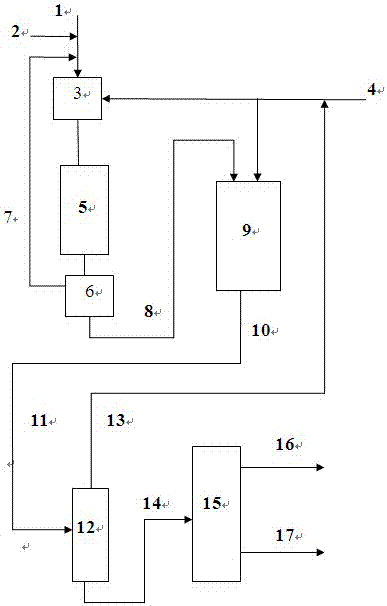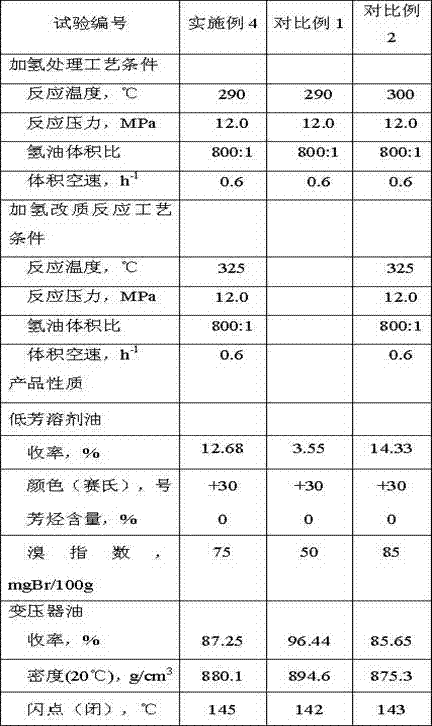A kind of rosin processing method
A treatment method, rosin technology, applied in chemical instruments and methods, chemical/physical processes, physical/chemical process catalysts, etc., can solve the problems of limited resources, waste of rosin resources, low purity, etc., to reduce investment and operating energy consumption , Low ring-opening activity, guaranteed product yield
- Summary
- Abstract
- Description
- Claims
- Application Information
AI Technical Summary
Problems solved by technology
Method used
Image
Examples
preparation example Construction
[0030] The preparation process of the hydrogenation modification catalyst of the present invention comprises: after uniformly mixing the amorphous silica-alumina and the modified Y zeolite, adding a binder, kneading, rolling into agglomerates, extruding on an extruder to obtain a carrier, Reload the hydrogenation active metal.
[0031] The preparation method of amorphous silicon aluminum used comprises the steps:
[0032] a. Prepare sodium aluminate solution and sodium silicate solution;
[0033] b. Add the sodium aluminate solution and the sodium silicate solution into the gel forming tank concurrently, and ventilate and feed CO at the same time 2 gas, adjust sodium aluminate solution, sodium silicate solution and CO 2 Flow rate, control the pH value of the material in the gel tank to 9-11, control the neutralization reaction temperature to 20-50°C, and the neutralization reaction time to 0.5-1.5 hours;
[0034] c. Under the controlled temperature and pH value of step b, t...
Embodiment 1
[0049] Prepare 700 solid sodium aluminate to a concentration of 200gAl 2 o 3 / L concentrated sodium aluminate solution, then diluted to a concentration of 35gAl 2 o 3 / L sodium aluminate working solution (a), take SiO 2 28wt% sodium silicate solution, then diluted to a concentration of 150gSiO 2 / L sodium silicate working solution 2L (b). Take a 30L steel plastic tank, open the container valves containing (a) and (b) respectively, and ventilate and feed CO with a concentration of 45v% at the same time 2 Gas, set the flow rate of (a) and (b) so that the reaction time is 1 hour, and quickly adjust the CO 2 flow rate, keep the pH of the system at about 10.0, and the reaction temperature is 30°C. After the reaction of (a) and (b) is completed, stop feeding CO 2 , and then the ventilation was stable for 40 minutes, and the slurry was filtered and washed with 85°C deionized water until neutral. Dry at 120°C for 8 hours, crush and sieve to obtain amorphous silica-alumina GL. ...
Embodiment 2
[0051] Get 80g silicon aluminum GL, 30g modified Y zeolite (SiO 2 / Al 2 o 3 40, unit cell constant 2.432nm, infrared acidity 0.19mmol / g specific surface 866m 2 / g, pore volume 0.52ml / g) and 250g adhesive made by peptizing nitric acid and SB alumina, kneading, rolling, making extrudable paste, extruding into strips. Carrier A was obtained by drying at 110°C for 6 hours and calcining at 550°C for 4 hours. Then 80 g of A was impregnated with 200 ml of a Mo-Mi co-impregnation solution in excess for 2 hours, dried at 110° C. for 6 hours, and calcined at 500° C. for 4 hours to obtain hydrogenation upgrading catalyst A. The physical properties of the hydrogenation upgrading catalyst are shown in Table 1.
PUM
| Property | Measurement | Unit |
|---|---|---|
| specific surface area | aaaaa | aaaaa |
| pore size | aaaaa | aaaaa |
| specific surface area | aaaaa | aaaaa |
Abstract
Description
Claims
Application Information
 Login to View More
Login to View More - R&D
- Intellectual Property
- Life Sciences
- Materials
- Tech Scout
- Unparalleled Data Quality
- Higher Quality Content
- 60% Fewer Hallucinations
Browse by: Latest US Patents, China's latest patents, Technical Efficacy Thesaurus, Application Domain, Technology Topic, Popular Technical Reports.
© 2025 PatSnap. All rights reserved.Legal|Privacy policy|Modern Slavery Act Transparency Statement|Sitemap|About US| Contact US: help@patsnap.com



